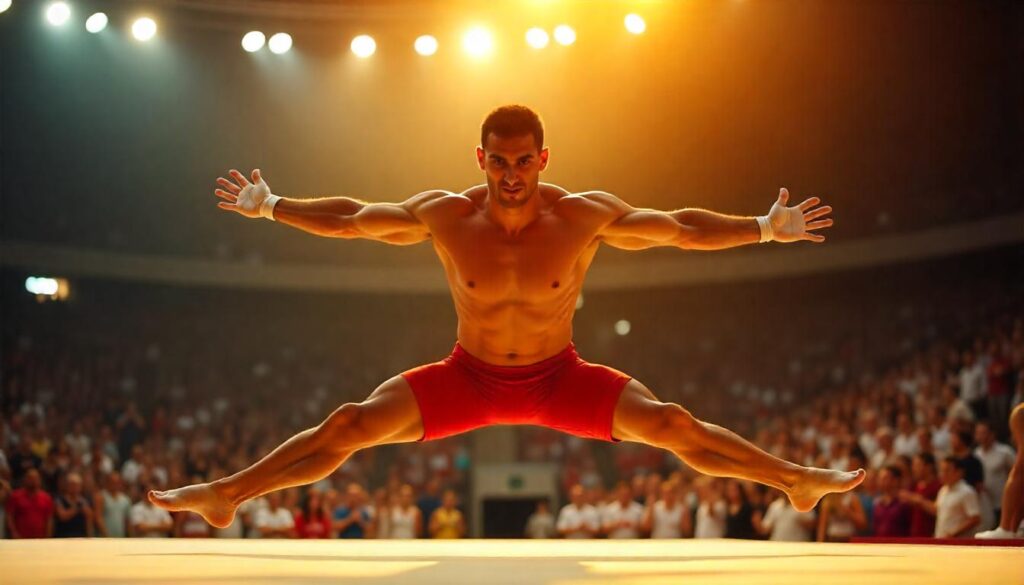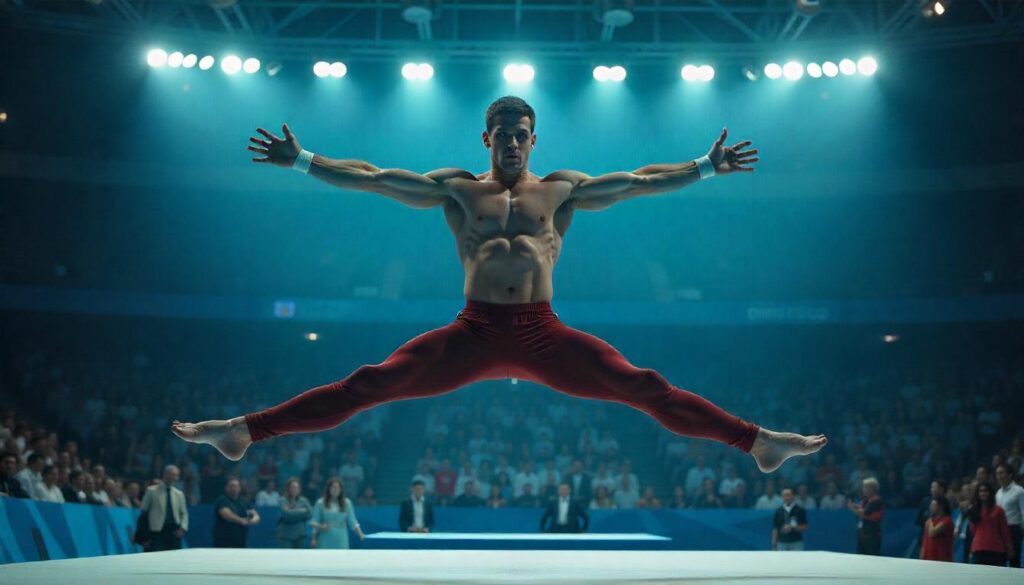Imagine holding yourself in mid-air, perfectly still, arms extended in a T-shape—every muscle shaking, yet controlled. That’s the Iron Cross. That’s the rings. That’s the Olympics.
If you’ve ever wondered what makes the gymnastics rings Olympics event so jaw-droppingly difficult—and so utterly captivating—you’re not alone. This is one of those events that turns ordinary gymnasts into legends. It’s a test of pure strength, meticulous technique, and ice-cold mental focus. And the 2024 Paris Olympics proved just how elite the competition has become.
Let’s dive into the fascinating world of Olympic rings gymnastics—where history, high-level athleticism, and human drama collide.
The Olympic Rings—No, Not Those Rings
Let’s get one thing straight. When we talk about Olympic rings in gymnastics, we don’t mean the five interlocked symbols of the Games. We’re talking about the still rings apparatus—those two suspended circles that gymnasts use to perform routines that seem to defy physics.
This event is part of men’s artistic gymnastics and has been since the very first modern Olympics in Athens in 1896. Women’s gymnastics, notably, does not include rings—raising some common PAA (People Also Ask) questions like, “Do female gymnasts use rings?” The answer is no; the rings remain a male-dominated Olympic apparatus, steeped in tradition and raw physicality.
Why Are Olympic Rings So Hard?
It’s simple: the rings don’t move unless you make them move. And once they do move, controlling them becomes exponentially harder.
Unlike other gymnastics apparatuses (like the floor or vault), the rings are suspended and unstable. That means gymnasts must generate and control every movement with insane body awareness and core strength. Imagine doing a push-up… in the air… without the ground… while being judged on your form. Sounds brutal? It is.
There’s a reason one of the most famous moves on rings is called the Iron Cross—a test of upper-body strength that looks as painful as it is powerful. And that’s just one element. Add in strength holds like the planche, inverted cross, or Maltese, and you’ve got a recipe for Olympic-level muscle control.

Biography Table for “Gymnastics Rings Olympics”
| Field | Details |
|---|---|
| Sport | Artistic Gymnastics |
| Apparatus Name | Still Rings (often called Gymnastics Rings) |
| Olympic Debut | 1896 Athens Olympics (Men’s Artistic Gymnastics) |
| Event Gender | Male-only event (no women’s division for rings in the Olympics) |
| Olympic Scoring Components | Difficulty Score (D-score) + Execution Score (E-score) – Neutral Deductions |
| Iconic Skills | Iron Cross, Maltese, Inverted Cross, Planche, Azarian, Yamawaki |
| Famous Olympic Athletes | Liu Yang (CHN), Eleftherios Petrounias (GRE), Zou Jingyuan (CHN), Chen Yibing (CHN), Jury Chechi (ITA), Albert Azaryan (URS) |
| Current Olympic Champions | Paris 2024: Gold – Liu Yang (CHN), Silver – Zou Jingyuan (CHN), Bronze – Eleftherios Petrounias (GRE) |
| Apparatus Specs | Rings 50 cm apart, 2.8 meters off the ground; attached to cables with 3-meter free-swing distance |
| Training Focus Areas | Static strength, core stability, shoulder mobility, body control, tendon strength |
| Scoring Rules | Based on FIG Code of Points; top 10 skills count toward difficulty, with severe deductions for instability or loss of form |
| Historical Highlights | Azaryan Cross invented by Albert Azaryan; Petrounias known as the “Lord of the Rings”; Liu Yang holds multiple national & Olympic gold medals |
| Notable Records | Liu Yang: 3x Chinese National Champion as of 2025; Petrounias: multiple European/Olympic medals |
| Why It’s Unique | Only apparatus requiring controlled stillness under extreme load; one of the most physically demanding Olympic events |
| Trending Topics | Paris 2024 results, FIG scoring changes, rings routine evolution, mental prep of elite gymnasts |
Olympic Gymnastics Rings Scoring: The Code You Didn’t Know You Needed to Crack
You might’ve seen the commentators throw around terms like D-score and E-score during Paris 2024, and thought, Wait, what are they talking about? Let’s simplify:
- D-score (Difficulty Score): Starts at 0.0. Gymnasts earn points for the hardest moves they successfully complete. Moves are ranked from A (easiest) to J (hardest), with J elements scoring a massive 1.0 point. The top 10 difficulty elements count, including strength holds and transitions.
- E-score (Execution Score): Everyone starts at 10.0. Judges deduct points for any mistake—bent elbows, shaky holds, poor landings. A small error costs 0.1, while a fall can take away a full point.
- Final Score = D + E – any neutral deductions (like time violations or stepping out of bounds).
So next time someone earns a 14.966, like Liu Yang did recently at the 2025 Chinese National Championships, you’ll know it’s not random—it’s the result of meticulous planning, flawless execution, and Herculean effort.

Paris 2024 Rings Recap: The Battle of the Giants
The 2024 Paris Olympics delivered one of the most nail-biting rings finals in recent memory. China dominated the podium, with Yang Liu capturing gold and Jingyuan Zou taking silver. Greek icon Eleftherios Petrounias, often referred to as “The Lord of the Rings,” secured bronze—adding yet another medal to his legacy.
Petrounias’ journey is the stuff of legend: an athlete who has defied injury and time, standing strong in a discipline where strength alone isn’t enough—you also need heart, artistry, and unshakable nerves.
The Evolution of the Rings: From Static Holds to Dynamic Mastery
Gymnastics rings routines have come a long way since the early 1900s. Back then, routines were almost entirely static—think long holds and slow transitions. Today’s athletes blend power with fluid motion, linking strength elements with swinging transitions and precisely stuck dismounts.
You’ll still see iconic moves like the Iron Cross or inverted cross, but now they’re embedded within high-speed routines that last just 60 seconds—but require years of training.
That evolution isn’t just aesthetic—it’s strategic. Higher D-scores require more complexity and creativity, so gymnasts are constantly pushing the boundaries of what’s humanly possible.
Who Are the Best Rings Gymnasts in Olympic History?
If you’re building your Mount Rushmore of Olympic rings specialists, here are some names you can’t ignore:
- Liu Yang (CHN): Two-time Olympic gold medalist, current reigning champion, and national hero in China.
- Eleftherios Petrounias (GRE): 2016 gold medalist, three-time World Champion, and the embodiment of consistency and grace.
- Chen Yibing (CHN): Known as the “Lord of the Rings” before Petrounias came along—his routines were almost robotically perfect.
- Yuri Chechi (ITA): Nicknamed “The Lord of the Rings” in the 1990s—his dominance inspired a generation.
These athletes aren’t just powerful—they’re also tacticians who understand the intricacies of scoring rules, routine construction, and mental preparation.
What It Takes to Train for Olympic Rings
Think it’s just about biceps? Think again.
Training for the Olympic rings involves:
- Isometric strength training – Holding difficult positions like planches and crosses for time.
- Core conditioning – Controlling swing elements and transitions.
- Joint stability work – Rings place intense strain on shoulders and elbows.
- Routine building – Planning each move for maximum points while minimizing risk.
And then there’s the mental side: dealing with pressure, sticking the dismount, and keeping your cool when the world’s watching.
Even beginner athletes can start building foundational strength using rings, though Olympic-level mastery is years—if not decades—in the making. The phrase “how to train for Olympic rings” isn’t just a search query—it’s a lifestyle.

Final Thoughts: Why the Gymnastics Rings Event Captivates Us Every Olympics
There’s something primal yet poetic about the gymnastics rings Olympics event. It’s one of the few places in sport where raw physical power meets quiet composure. Where a single second of hesitation can cost you everything, and where stillness—yes, stillness—can earn you gold.
Whether you’re watching from the edge of your couch during the Summer Games or inspired to hang some rings in your garage, this apparatus carries a legacy that’s over a century old—and still evolving.
So next time you see an athlete lock into an Iron Cross or dismount with flawless control, take a moment. You’re witnessing one of the purest forms of Olympic excellence.
